Fuel Sender
Removing the fuel sender from the MK2 CRX.
Important - Read this First!
Before removing the sender make sure the level in
tank is as low as possible, and use common sense when
working with an open fuel tank. Keep the doors open to
prevent a build up of vapour in the car, which can
easily be ignited with a spark. If you are working in a
garage, make sure there is plenty of ventilation, and
those around you know there is an open fuel tank.
Naturally, if you intend to have the sender unit out
for any length of time, you should drain the tank
completely.
It's also worth mentioning that to gain access to the
fuel pump you must remove the tank from the car, as it
is offset to one side under the body.
Removal
The car shown here is a 1991 CRX, however removal is
similar for a wide range of Honda vehicles. There is no
need to remove the tank from the car to get to the
sender as there is an access hole under the back seat.
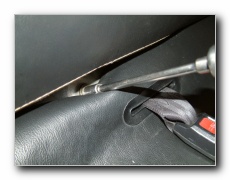 |
Remove the 10mm retaining bolt for the seat, pass the
seat belt buckles through the openings and then flip up
the seat from the rear to a vertical position and unhook
at the front. It should just lift out. |
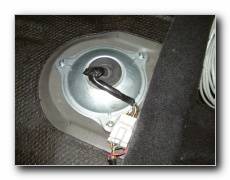 |
Remove the 10mm retaining bolt for the seat, pass the
seat belt buckles through the openings and then flip up
the seat from the rear to a vertical position and unhook
at the front. It should just lift out.
With the seat removed, you can see the access hatch.
Unplug the connector and undo the screws to remove the
cover. |
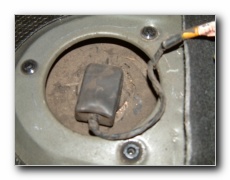 |
You can now unplug the connector to the sender unit
itself, the other wires running off along the top of the
tank are for the fuel pump. |
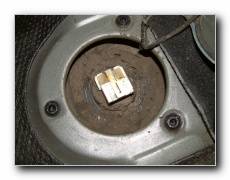 |
With the connector to the sender unplugged, wash round
the top of the tank with a strong detergent and brush to
remove all the dust as you don't want it to fall into
the tank, it also allows you to get a clearer view of
the retaining ring. Was away the detergent with water -
it will run out off the top of the tank, so it's best to
do this job outside. Do not worry about getting any
water inside the tank, as the sender unit is well sealed
although naturally you should dry off any excess water. |
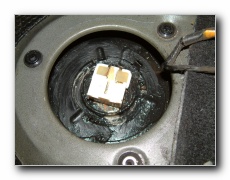 |
With everything clean you can see the retaining ring.
Honda have a special tool available at cost to remove
this ring, but you can make do with a large screwdriver
or preferably steel rod to gently tap the ring round.
You may be able to loosen it with a pair of large long
nosed pliers, but it usually need some persuasion the
first time. Be careful not to bend or twist the
retaining ring, it does not need much force to remove
it. You must rotate it anticlockwise until the lugs line
up the bracket on the tank, allowing you to lift out the
ring. The ring has a cam on it to press the sender unit
and seal down hard to the tank - once this has been
passed it should spin round without too much trouble,
depending on how much dust & grit is still stuck in the
ring & bracket!
|
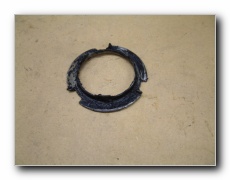 |
When the ring is free,
carefully lift out the sender and be careful not
to bend the float arm. It has a rubber seal
which may fall down when the sender is lifted
out, so make sure to take note of which way
round it fits. |
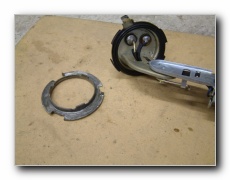 |
It's also worthwhile to clean
up the ring and top of the sender unit now they
are out. |
Refitting
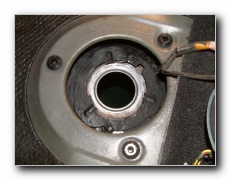 |
To refit the sender, make sure the rubber seal is
correctly fitted on the sender unit. |
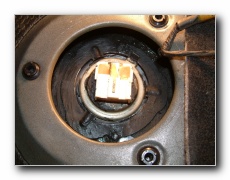 |
Now place the sender unit into the tank, making sure it
is correctly located - there is a tab on the top that
lines up with a groove on the ring's bracket. |
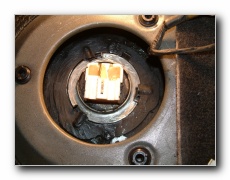 |
Now place the cleaned up ring into the bracket and let
it drop down, you will have to press down on the sender
to compress the seal while doing this. Note that the
sender on the B16 engined cars is slightly different to
the earlier D series models, as it is spring
loaded to press down on the bottom of the tank,
so requires a little more force. |
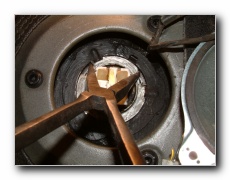 |
I managed to tighten the ring with a
some long nosed pliers. Tighten the ring until it
reaches the end stop, do not force it and be careful not
to distort the ring or the bracket. |
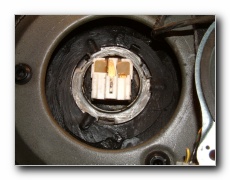 |
The ring correctly installed. |
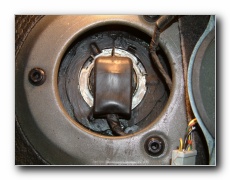 |
You can now install the connector again, notice that i
have also cleaned up the rubber cover to keep everything
tidy. Screw the access hatch back down, plug in the
connector to the main loom, and that's it. |














